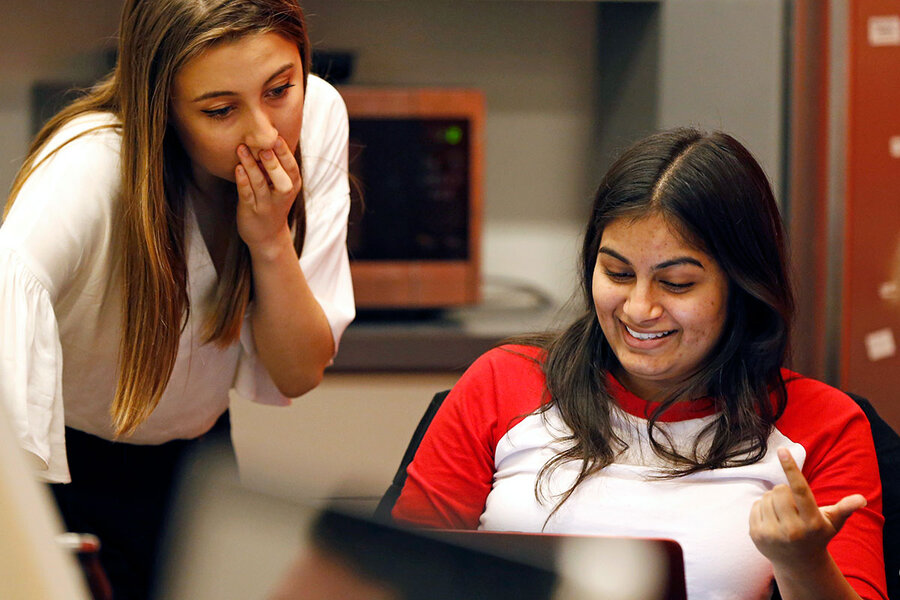Campus newsrooms rethink their approach to race
Loading...
This spring, college students across the United States saw several high-profile cases of racial discrimination. At Colorado State University in Fort Collins, a white woman on a tour called campus police after feeling unsafe while walking near two prospective Native American students. And at the University of California, San Diego, members of a white supremacist organization interrupted a class lecture and posted racist pamphlets across campus. In light of events like these, campus publications have been reexamining how they cover race and identity. Their approaches are wide-ranging, including assigning beat reporters to cover marginalized communities, running racial bias workshops, and working to diversify their staffs. Along the way, college papers are leading the effort to bring more diversity to the industry, and grooming new editors and reporters who may soon take their diversity-forward worldviews to professional newsrooms. “The heightened dialogue about the underrepresentation of people of color in media is very much making itself felt in the college newsroom,” says Frank LoMonte, director of the Brechner Center for Freedom of Information at the University of Florida in Gainesville.
Why We Wrote This
In recent years, college campuses have seen controversy erupt around race and identity. For student journalists, this moment has triggered deeper questions about diversity within their own coverage.
As the editor in chief of the Daily Gamecock at the University of South Carolina a decade ago, Jackie Alexander still remembers a story she assigned a white student reporter. It was the spring of 2008 and in recognition of Barack Obama’s historic presidential candidacy, Ms. Alexander asked the reporter to cover race relations on campus.
The story the reporter submitted depicted a harmonious, inclusive environment. Only three sources were quoted and none of them were black. For Alexander, who at times had faced racist aggression as a black student on a predominantly white campus, it was a powerful glimpse into her colleague’s racial blind spots – especially at a newspaper where only two students on a staff of 80 were people of color.
“Without that person to push back and say ‘This isn't an accurate representation for the lived experiences of these people, my people,’ you get stories like ‘Everything is Hunky-Dory at Carolina,’ because they don't have the frame of mind to challenge their own assumptions and biases,” says Alexander, now the director of student media at the University of Alabama at Birmingham.
Why We Wrote This
In recent years, college campuses have seen controversy erupt around race and identity. For student journalists, this moment has triggered deeper questions about diversity within their own coverage.
“[S]ometimes having that very awkward conversation with people who should get it… can be very frustrating and demoralizing,” she says.
Data show that journalism today continues to be an overwhelmingly white profession. In 2017, racial minorities comprised about 16.6 percent of all newsroom employees surveyed by the American Society of News Editors.
But on college campuses, where racial awareness and debate have heightened recently, student newspapers are now leading the effort to bring more diversity to the industry.
Their approaches are wide-ranging, including assigning beat reporters to cover marginalized communities, running racial bias workshops, and recruiting for greater racial diversity within their own staffs. Along the way, these young journalists are grooming new editors and reporters who may soon take their diversity-forward worldviews to professional newsrooms.
“The heightened dialogue about the underrepresentation of people of color in media is very much making itself felt in the college newsroom,” says Frank LoMonte, Director of the Brechner Center for Freedom of Information at the University of Florida in Gainesville.
“We’re at a moment where people of color are standing up and demanding to be heard in the media, and rightly so. As an editor you ignore that at your great peril,” says Mr. LoMonte.
Turning the page on underrepresentation
This spring, college students across the country saw several high-profile cases of racial discrimination, many of which played off of the tensions Alexander witnessed ten years ago. At Colorado State University in Fort Collins, a white woman on a tour called the campus police after feeling unsafe while walking near two Native American prospective students. And at the University of California San Diego, members of a white supremacist organization interrupted a class lecture and posted racist pamphlets across campus.
These incidents echoed a series of racial profiling cases on college campuses in 2015 that ignited protests across the US and drove at least 79 institutions to petition their administrations to better protect community members of color. Student media found itself caught up in this wave of activism, most notably when a former University of Missouri professor threatened a student photographer on assignment for ESPN for trying to document protests there.
In light of events like these, editors at campus publications have been reexamining how they cover race and identity. This spring, Hannah Bernstein, managing editor of The Huntington News at Northeastern University in Boston, led a racial bias workshop in her newsroom. She encouraged reporters to meaningfully engage with reader feedback, including accusations of racially insensitive coverage.
The newspaper struggles with diversity, says Ms. Bernstein’s colleague, Jasmine Heyward.
“I think the dominant perspective [at the paper] can be people who tend to be white, tend to be from middle to upper class backgrounds, tend to be straight, and tend to have this ‘We’re journalists, we make change by covering the news not by being the news’ mindset,” says Ms. Heyward, one of the few students of color on staff.
Some universities are developing new standards. The Diversity Style Guide was created by the Center for Integration and Improvement of Journalism at San Francisco State University and includes suggestions such as capitalizing the “b” in “black” for describing race and using “Latinx” as a gender-neutral term for members of the Latino community.
“When you’re presenting the opinions of people of color and you... diminish their experiences in any way, it really diminishes the trust over time that they’ll have in your paper. That means being super cognizant [about] how you talk about diversity in your writing,” says Gabriel Schneider, the former editor in chief of the Triton, an independent newspaper at the University of California San Diego that incorporated the Diversity Style Guide into its editorial guidelines.
At the University of Alabama Birmingham, Alexander helped develop a diversity rubric for student reporters to determine the number of minority sources they used.
“That’s kind of a quantitative reminder. It’s not to set a quota,” she says.
Supporting students of color
To bring more diversity to its publication, The Daily Californian, the student paper of The University of California, Berkeley, unveiled a series of initiatives this past year. They include creating a new column devoted to the experiences of students of color, forming an internal diversity committee to assess the paper’s racial coverage, and establishing beat reporters to cover marginalized identities.
However, while 18.6 percent of the student body identified as black or Latino in 2017, the paper is still working to bring the share of black and Latino staff above 7 percent.
One problem may be the long hours and low pay at newspapers, says Jimena Tavel, the outgoing managing editor of The Independent Florida Alligator, a student newspaper at the University of Florida in Gainesville. Many student papers can’t afford to pay their staffs at all and others offer editors a meager stipend that equates to just a few dollars an hour.
In April, Ms. Tavel cofounded #SaveStudentNewsrooms, a campaign to raise awareness about the struggles student newsrooms face and to secure funding to hire more racially diverse staffs.
'College newsrooms are uniquely dynamic'
Despite challenges, many editors are optimistic. In San Diego, the Triton’s staff has grown from three bloggers to more than 60 editors and writers – predominantly students of color – in three years, says Mohamed Al Elew, the current editor in chief. And unlike the greater media industry, college newsrooms are uniquely dynamic, says LoMonte.
“If you’re the New York Times, it’s really hard to diversify your newsroom overnight because you’re looking for people with decades of experience that you’re going to pay six-figure salaries,” he says.
“At the college newsroom you can just throw the door open and let everybody who wants to come in, come in. Just pull up another chair. There’s plenty of room.”
Monitor staff Grace Elletson contributed to this report.









